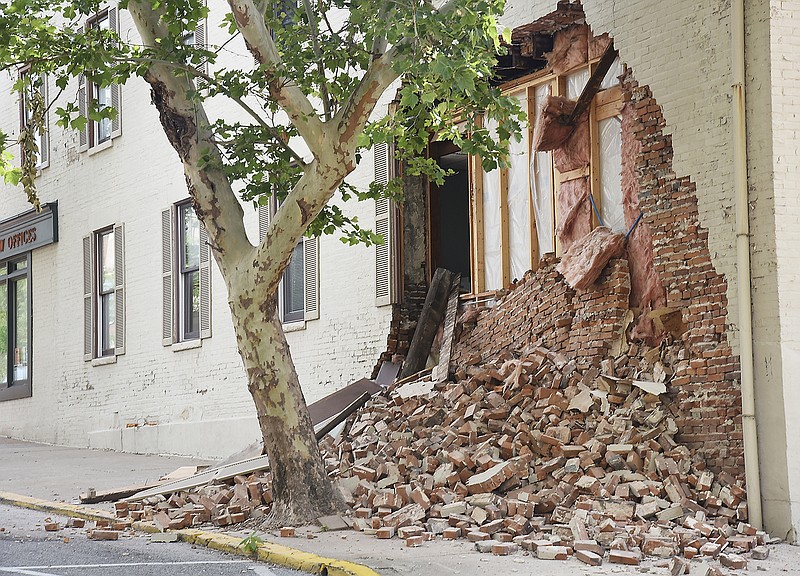Water infiltration caused the wall of a downtown building to partially collapse earlier this summer, city staff reported Tuesday evening.
Property owner Andrew Neidert voluntarily plans to demolish 200 E. High St., Jefferson City Building Official Larry Burkhardt said last month. In early June, the wall facing Madison Street partially collapsed after water washed out the mortar that held the bricks together. The wall "then somehow received an off-balanced load to prompt the collapse," according to a memorandum from Burkhardt to the Jefferson City Historic Preservation Commission.
The remaining walls of the building also have water infiltration and will need to be repaired, according to the memorandum. The buildings at 200 E. High St. and 202 E High St. share an adjacent wall, which has also been compromised and will need repair.
After the wall on 200 E. High St. partially collapsed, the building was deemed dangerous under city code. A barricade currently prevents the public from getting near the wall, and traffic is diverted around the building.
The value of the property improvements is $276,500, Burkhardt stated. The repair cost would "greatly exceed 50 percent of this value," he added, so the city has "the right to order it be repaired or demolished."
If Neidert had not decided to pursue demolition, the city "would have eventually abated the nuisance by demolition," Burkhardt said in the memorandum.
Since the structure is deemed dangerous, Jefferson City Neighborhood Services Manager Jayme Abbott said, the building bypassed the Historic Preservation Commission's demolition clearance process.
The building used to house law firms Berry Wilson LLC and Turnbull & Stark LLC.
Also on Tuesday, the Historic Preservation Commission recommended approval of an amendment to the local historic district section of the city code that would allow properties to be included in an already established local historic district to submit an application.
If property owners want their properties to be included in an established local historic district, they would submit their applications to the city, which would go to the Historic Preservation Commission and Jefferson City Planning and Zoning Commission for review. After the two commissions submit their recommendations, the application would go to the Jefferson City Council for final approval.
Under the proposed amendment, parcels must be directly abutting the established district.
The City Council will hold a public hearing Monday regarding the proposed amendment.
Currently, the city code does not allow a local historic district application to be amended without the application going through the entire process again.
The City Council directed city staff last month to create a mechanism that allows an established local historic district to be expanded after several individuals with Quinn Chapel A.M.E. Church requested the church be included in the School Street local historic district application. At that time, the School Street local historic district application was placed on the informal calendar.
The School Street application currently encompasses 27 parcels - including properties in the 600 block of East McCarty Street, all of School Street, the 400 block of Lafayette Street, three houses on the east side of Lafayette Street, one house on East Miller Street and 500 Lafayette St. It does not include Quinn Chapel.
"City Council could pull (the School Street local historic district) item off the informal calendar and vote on that in order to establish that district," Barron said last week. "That would put the district in place, and (if the proposed amendment is approved) that would allow the church to apply at their own leisure to be added to the district. It would put in place the mechanism for them to pursue that route."
The amendment is not specific for the School Street local historic district application as this amendment would apply to any local historic districts, if approved by the council.
The Planning and Zoning Commission recommended approval of the amendment last week.
The Historic Preservation Commission also recommended approval Tuesday of a city-proposed bill that would establish the National Register Historic Overlay District. The district would encompass seven areas listed on the National Park Service's National Register of Historic Places.
These places are the Missouri State Capitol Historic District, Capitol Avenue Historic District, Moreau Drive Historic District, Lincoln University Hill Top Campus District, Broadway-Dunklin Historic District, Munichburg Commercial Historic District and Hobo Hill Historic District.
If established, it would be the city's third overlay district. Jefferson City currently has the Capitol Avenue Neighborhood Conservation Overlay District and the Lower Jefferson Conservation Overlay District.
A recently passed Missouri House bill allows wireless telecommunications companies to place small wireless antennas and facilities in public rights-of-way. However, companies wanting to place these items in areas zoned historic as of Aug. 28 must go through public hearing procedures.
"This will allow public input on the impact of these facilities in historic areas and will give the city the ability to work with wireless telecommunications companies to figure out a deployment strategy that works for both the company and a neighborhood," the city staff analysis states.
The Planning and Zoning Commission recommended approval of the bill last week.
The City Council will hold a public hearing on the bill Monday.

